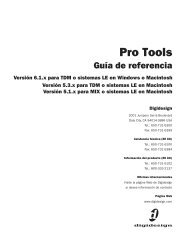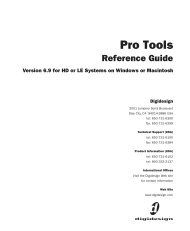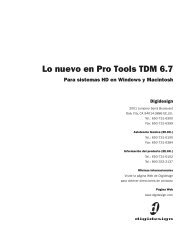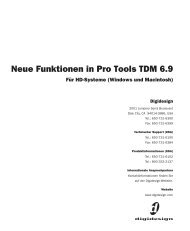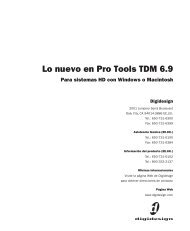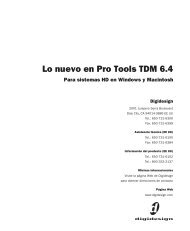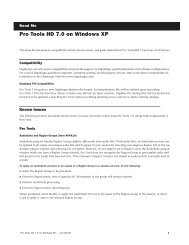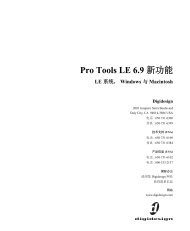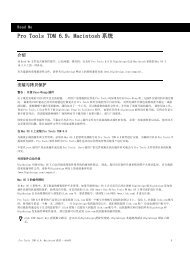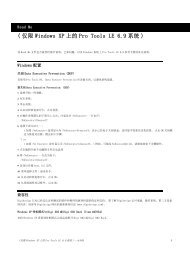5.1 DigiRack Plug-Ins Guide - Digidesign Support Archives
5.1 DigiRack Plug-Ins Guide - Digidesign Support Archives
5.1 DigiRack Plug-Ins Guide - Digidesign Support Archives
You also want an ePaper? Increase the reach of your titles
YUMPU automatically turns print PDFs into web optimized ePapers that Google loves.
40<br />
Using TimeAdjuster for Delay<br />
Compensation<br />
DSP processing in all digital systems incurs delay<br />
of varying amounts. You can use the Time-<br />
Adjuster TDM plug-in to apply an exact number<br />
of samples of delay to the signal path of a<br />
Pro Tools track to compensate for delay incurred<br />
by specific plug-ins. TimeAdjuster provides presets<br />
for common delay-compensation scenarios.<br />
To compensate for several plug-ins in-line, use<br />
the delay times from each settings file as references,<br />
and add them together to derive the total<br />
delay time.<br />
Alternatively, look up the delay in samples for<br />
the plug-ins you want to compensate for, then<br />
apply the appropriate amount of delay.<br />
A delay table for <strong>DigiRack</strong> plug-ins appears<br />
in Appendix B, “DSP Delays Incurred by<br />
TDM <strong>Plug</strong>-<strong>Ins</strong>.”<br />
To compensate for DSP-induced delays, try one<br />
of the following methods:<br />
Phase Inversion<br />
If you are working with phase-coherent track<br />
pairs, or tracks recorded with multiple microphones,<br />
you can use a common studio technique<br />
to null out the delay. Flop the phase of<br />
the target track using the TimeAdjuster plug-in’s<br />
Phase Invert button, and adjust the plug-in’s delay<br />
time until the signal disappears. Then disengage<br />
the Phase Invert button.<br />
If you don’t hear any audio when you flop a signal’s<br />
phase, you have precisely adjusted and<br />
compensated for the delay. This is because when<br />
you monitor duplicate signals and invert the po-<br />
<strong>DigiRack</strong> <strong>Plug</strong>-<strong>Ins</strong> <strong>Guide</strong><br />
larity (phase) of one of them, the signals will be<br />
of opposite polarity and cancel each other out.<br />
This method is convenient for finding the exact<br />
delay setting for any plug-in.<br />
To determine the delay of a plug-in by inverting its<br />
signal phase:<br />
1 Place duplicate audio regions on two different<br />
audio tracks and pan them to the center<br />
(mono).<br />
2 Apply the plug-in whose delay you want to<br />
calculate to the first track, and a Time Adjuster<br />
plug-in to the second track.<br />
3 With TimeAdjuster, reverse the phase.<br />
4 Command-drag (Macintosh) or Control-drag<br />
(Windows) to fine-tune delay in one sample increments,<br />
or use the up/down arrow keys to<br />
change the delay one sample at a time until the<br />
audio signal disappears.<br />
5 Flop the polarity back to normal.<br />
6 Save the TimeAdjuster setting for later use.<br />
Comb-Filter Effect Cancellation<br />
Adjust the delay with the signal in phase until<br />
any comb-filter effects cancel out.<br />
Viewing Channel Delay<br />
Because TDM plug-ins display their delay values<br />
in the Mix window’s channel delay indicators,<br />
there is a third method for determining delay<br />
compensation, performed as follows.



